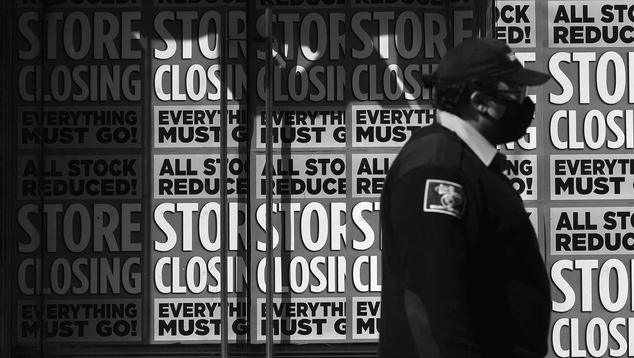New Gallup Panel survey data from April 13-19 show that 33% of adults in the U.S. labor force have been laid off or have seen reduced hours because of COVID-19. That amounts to an estimated 54 million U.S. workers.
April Unemployment Rate Could Be as High as 15%
These data suggest that the May 8 U.S. Bureau of Labor Statistics (BLS) report will show an unemployment rate ranging from as low as 7.5% to as high as 14.6%, depending on how successfully the BLS is able to classify furloughed workers as unemployed, given the unusual circumstances of the pandemic. Only 7.5% of respondents who would be considered part of the labor force, using conventional definitions, report being unemployed and not looking for work, but a large number of workers also report that they have been temporarily laid off, and the BLS intends to count these workers as unemployed regardless of whether they are looking for work or not.
Four in 10 Laid-Off Workers Approved for Unemployment Insurance
A Gallup survey conducted April 20-26 addresses the adequacy of economic relief programs in the U.S. The data show that 43% of laid-off workers have been approved for unemployment insurance.
Additionally, estimates indicate that 20% of small businesses have been approved for the Paycheck Protection Program (PPP), representing roughly 10 to 16 million workers (or 6% to 10% of the labor force). Among a group of 20 wealthy countries analyzed in a recent Brookings report, the U.S. has seen the largest surge in the number of workers filing for unemployment insurance benefits as a share of its workforce.
Half of Businesses Receiving PPP Don't Need It
Unlike income support programs in other countries, such as in New Zealand and Ireland, the PPP compensates businesses regardless of whether they have seen revenue losses, raising concerns about inefficiency and poor targeting. This aspect of the law is reflected in Gallup's survey data of business owners, which finds that 17% of small-business owners with income losses report receiving PPP, compared with 20% of all small-business owners. The data show that roughly half of PPP recipients (48%) do not report a loss in income.
What the BLS Is Likely to Report
There are good reasons to expect that the BLS unemployment numbers will be grim. As of the week ending April 25, 28.1 million Americans (17% of the workforce) had filed for unemployment insurance since early March, according to administrative data from the Department of Labor. (The claims numbers are slightly higher if a seasonal adjustment factor is applied.) For the upcoming BLS reporting period, the relevant number of claims from the Department of Labor as a share of the workforce is 15%. This suggests that the BLS official unemployment rate could be around that number, but not everyone who is unemployed files a claim -- and because of changes in eligibility rules, not everyone who receives unemployment insurance benefits is out of work.
Gallup has polled on employment and coronavirus-related topics since March 13 through a COVID-19 tracking survey and added questions on March 27 to explicitly measure economic harm from COVID-19. Gallup has used a more limited set of survey items than the BLS and different wording, so the numbers are unlikely to match exactly -- but as The Wall Street Journal reported in 2016, Gallup's unemployment estimates from past surveys have been very similar to those from the BLS. The current Gallup survey uses slightly different employment items, but in the early weeks of the pandemic, the estimates were close to the official BLS unemployment rate for early March.
Two measures were constructed to attempt to predict the official unemployment rate for the week ending April 25.
The first uses only Gallup's single-item employment measure, which asks people to describe their "employment situation" in the past seven days. Being employed means working full time or part time for pay. Not being employed is more complicated. Alternatives include being a homemaker, a full-time student or a retiree, all of which are considered options that would typically classify someone as out of the labor force and ignored in the official unemployment rate. Gallup also allows people to say they are "unemployed/laid off and not looking for work" or "unemployed/laid off but looking for work."
In most cases, people who say they are unemployed and not looking for work would be counted as out of the labor force by the BLS when calculating the official unemployment rate. The one important exception is that workers are counted as unemployed if they say the main reason they were absent from work last week was that they were "on layoff" but that they expect to be recalled within six months. For these temporarily laid-off workers, the BLS does not require that they are actively looking for work to be part of the labor force, and therefore, they should be counted as unemployed.
The federal government shutdown of early 2019 provided a recent episode in which many workers were furloughed, presenting challenges for the BLS. In that case, 104,000 federal workers were classified as temporarily on layoff, according to a BLS retrospective report. Yet, another 153,000 did not meet the criteria for being counted as on layoff, because they told the BLS they were absent from work for some "other" unspecified reason (presumably, they might have said "the shutdown" if that were an option). The BLS considered these workers to be misclassified as employed, but they did not correct the data to maintain its integrity and consistency with established methods.
To avoid this scenario during COVID-19, the BLS instructed survey interviewers in March to classify people who said they were absent from work as a result of the coronavirus as unemployed on temporary layoff. In mid-March, the BLS recorded a large increase (of 1.1 million, between February and March) in the number of people classified as unemployed on temporary layoff, but the agency also noted a large increase in the number of people classified as employed but absent from work (roughly 1.6 million). This suggests that the BLS coding rules still allow for some ambiguity when it comes to classifying workers furloughed from COVID-19.
To follow the BLS methods as closely as possible using the Gallup Panel, all individuals are classified as unemployed if they say they are unemployed and looking for work, and as being in the labor force if they are employed or if they are unemployed and looking. The table below shows that the unemployment rate increased from 5.0% in mid-March (close to the BLS unadjusted measure of 4.5%) to 7.5% by the week ending April 19. This method, however, fails to count many furloughed workers as unemployed, since most of them are not looking for work. Therefore, an additional measure was created that reclassifies survey respondents who report being temporarily laid off and not looking for work as unemployed. This nearly doubles the unemployment rate, to 14.6%.
Given this, it is estimated that the official BLS unemployment rate for April will fall somewhere between 7.5% and 14.6%, depending on how successful the BLS is at reclassifying furloughed workers. If the agency meets its goals, it should be close to the 14.6% estimate. It should be noted that 12.6% and 16.6% are within the 95% confidence interval for this upper-end unemployment estimate.
| Mar 13-15 | Mar 16-22 | Mar 23-29 | Mar 30-Apr 5 | Apr 6-12 | Apr 13-19 | ||||||||||||||||||||||||||||||||||||||||||||||||||||||||||||||||||||||||||||||||||||||||||||||
|---|---|---|---|---|---|---|---|---|---|---|---|---|---|---|---|---|---|---|---|---|---|---|---|---|---|---|---|---|---|---|---|---|---|---|---|---|---|---|---|---|---|---|---|---|---|---|---|---|---|---|---|---|---|---|---|---|---|---|---|---|---|---|---|---|---|---|---|---|---|---|---|---|---|---|---|---|---|---|---|---|---|---|---|---|---|---|---|---|---|---|---|---|---|---|---|---|---|---|---|
| % | % | % | % | % | % | ||||||||||||||||||||||||||||||||||||||||||||||||||||||||||||||||||||||||||||||||||||||||||||||
| Cumulative unemployment insurance claims as share of workforce (not seasonally adjusted)* | 0.2 | 1.9 | 5.6 | 9.4 | 12.4 | 15.0 | |||||||||||||||||||||||||||||||||||||||||||||||||||||||||||||||||||||||||||||||||||||||||||||
| Unemployed and looking for work as share of workforce | 5.0 | 4.2 | 6.9 | 6.4 | 7.4 | 7.5 | |||||||||||||||||||||||||||||||||||||||||||||||||||||||||||||||||||||||||||||||||||||||||||||
| Unemployed, including temporarily laid-off workers, as share of workforce | - | - | 9.1 | 12.1 | 12.6 | 14.6 | |||||||||||||||||||||||||||||||||||||||||||||||||||||||||||||||||||||||||||||||||||||||||||||
| Percentage of workers laid off as a result of coronavirus | - | - | 14.5 | 15.1 | 15.7 | 18.0 | |||||||||||||||||||||||||||||||||||||||||||||||||||||||||||||||||||||||||||||||||||||||||||||
| Percentage of workers laid off or put on reduced hours | - | - | 27.6 | 28.2 | 29.9 | 33.1 | |||||||||||||||||||||||||||||||||||||||||||||||||||||||||||||||||||||||||||||||||||||||||||||
| *From the U.S. Bureau of Labor Statistics | |||||||||||||||||||||||||||||||||||||||||||||||||||||||||||||||||||||||||||||||||||||||||||||||||||
| Gallup Panel, 2020 | |||||||||||||||||||||||||||||||||||||||||||||||||||||||||||||||||||||||||||||||||||||||||||||||||||
Gallup's Estimates of Economic Harm
Whatever the official unemployment rate is for April, it will understate the true economic damage because it does not include those with reduced hours or pay. This number can best be calculated from BLS data by adding the change in total employment (in other words, job losses) to the number of workers who were forced to drop from full time to part time for economic reasons. In the March release, this number was 4.1 million, which is much higher than the reported change in the number of unemployed workers (1.1 million). Another way to measure economic harm would be to look at what the BLS calls U6 unemployment. This includes in the total number of unemployed workers anyone who is not working but wants a job plus those working part time for economic reasons (as opposed to a personal preference). These workers represented 2.5 million people in the March release.
Gallup also has estimates for these more comprehensive measures of harm. Defined as anyone who has been laid off or has seen reduced hours as a result of COVID-19, one-third of the labor force has been harmed. That means 54 million workers. Thus, it is expected that BLS data would show that roughly 50 million workers had either lost their job or faced reduced hours between February and April.
An Assessment of Relief Programs
Thus far, Department of Labor data show that 17.8 million people have filed a continued claim for unemployment insurance, suggesting that 63% of the 28.1 million people who filed for unemployment have received a benefit. This is close to our estimate from survey work conducted April 20-26, which shows that 55% of those who have applied report being approved. We find that the approval rate is 65% among laid-off workers who have applied for benefits.
That still leaves a large number of people without benefits. Indeed, we estimate that 43% of all workers who have been laid off have been approved for unemployment insurance benefits. The share is even lower (14%) for those facing reduced hours.
| U.S. adults | Laid off | Hours reduced | Laid off/Hours reduced | ||||||||||||||||||||||||||||||||||||||||||||||||||||||||||||||||||||||||||||||||||||||||||||||||
|---|---|---|---|---|---|---|---|---|---|---|---|---|---|---|---|---|---|---|---|---|---|---|---|---|---|---|---|---|---|---|---|---|---|---|---|---|---|---|---|---|---|---|---|---|---|---|---|---|---|---|---|---|---|---|---|---|---|---|---|---|---|---|---|---|---|---|---|---|---|---|---|---|---|---|---|---|---|---|---|---|---|---|---|---|---|---|---|---|---|---|---|---|---|---|---|---|---|---|---|
| % | % | % | % | ||||||||||||||||||||||||||||||||||||||||||||||||||||||||||||||||||||||||||||||||||||||||||||||||
| Eligible for benefits | 11 | 54 | 25 | 35 | |||||||||||||||||||||||||||||||||||||||||||||||||||||||||||||||||||||||||||||||||||||||||||||||
| Percentage who applied | 9 | 66 | 30 | 40 | |||||||||||||||||||||||||||||||||||||||||||||||||||||||||||||||||||||||||||||||||||||||||||||||
| Approval rate for those who applied | 55 | 65 | 47 | 58 | |||||||||||||||||||||||||||||||||||||||||||||||||||||||||||||||||||||||||||||||||||||||||||||||
| Percentage of total population who were approved | 5 | 43 | 14 | 23 | |||||||||||||||||||||||||||||||||||||||||||||||||||||||||||||||||||||||||||||||||||||||||||||||
| Gallup Panel, Apr 20-26, 2020 | |||||||||||||||||||||||||||||||||||||||||||||||||||||||||||||||||||||||||||||||||||||||||||||||||||
One question is whether alternative relief programs have filled the gaps. The most prominent candidate is the PPP, which was recently signed into law to provide loans -- that can be forgiven if certain conditions are met -- to small businesses to retain their workers on the payroll.
So far, only 2% of all U.S. adults and 4% of adults with income loss have been approved for the program, but this is not surprising since it is generally only relevant for the self-employed, nonprofit leaders and business owners with fewer than 500 employees. Almost half of small-business owners surveyed as part of the Gallup COVID-19 tracking study have applied for the program, whether or not they have lost income as a result of COVID-19. In fact, the correlation between loss of income and approval for PPP is not significant, providing evidence that the program has benefited companies regardless of whether they've been harmed by the pandemic. The approval rate has been just over 40% among those who have applied, meaning that around one in five U.S. small-business owners have been approved for program benefits. Another way of stating this is that 80% of small-business owners who've lost income as a result of COVID-19 have not been approved for PPP funding.
| U.S. adults | All adults with income loss | Small-business owners | Small-business owners with income loss | ||||||||||||||||||||||||||||||||||||||||||||||||||||||||||||||||||||||||||||||||||||||||||||||||
|---|---|---|---|---|---|---|---|---|---|---|---|---|---|---|---|---|---|---|---|---|---|---|---|---|---|---|---|---|---|---|---|---|---|---|---|---|---|---|---|---|---|---|---|---|---|---|---|---|---|---|---|---|---|---|---|---|---|---|---|---|---|---|---|---|---|---|---|---|---|---|---|---|---|---|---|---|---|---|---|---|---|---|---|---|---|---|---|---|---|---|---|---|---|---|---|---|---|---|---|
| % | % | % | % | ||||||||||||||||||||||||||||||||||||||||||||||||||||||||||||||||||||||||||||||||||||||||||||||||
| Eligible for PPP loan | 7 | 12 | 43 | 41 | |||||||||||||||||||||||||||||||||||||||||||||||||||||||||||||||||||||||||||||||||||||||||||||||
| Percentage who applied | 5 | 11 | 44 | 42 | |||||||||||||||||||||||||||||||||||||||||||||||||||||||||||||||||||||||||||||||||||||||||||||||
| Approval rate for those who applied | 45 | 41 | 46 | 41 | |||||||||||||||||||||||||||||||||||||||||||||||||||||||||||||||||||||||||||||||||||||||||||||||
| Percentage of total population who were approved | 2 | 4 | 20 | 17 | |||||||||||||||||||||||||||||||||||||||||||||||||||||||||||||||||||||||||||||||||||||||||||||||
| Gallup Panel, Apr 20-26, 2020 | |||||||||||||||||||||||||||||||||||||||||||||||||||||||||||||||||||||||||||||||||||||||||||||||||||
The Small Business Administration reported that 1.6 million PPP loans had been approved through April 16 and an additional 2.2 million through May 1, with an average loan amount of $133,750. Using employee compensation data from the Social Security Administration as a benchmark, it is estimated that somewhere between 10.4 and 15.7 million workers have indirectly benefited from the PPP. That is certainly a substantial number of workers (6% to 10% of the labor force) -- but even at the high end, that is far fewer than the 28.1 million who have filed unemployment insurance claims and far fewer than the roughly 50 million who report being either laid off or working reduced hours.
The failure to get unemployment benefits to those laid off from COVID-19 is particularly striking given that the U.S. has relied far more on the unemployment insurance system than other OECD countries have, as recently found in the analysis published by the Brookings Institution. In the sample of 20 wealthy countries, no other nation has seen a larger share of its workforce file for unemployment insurance. Instead, other countries -- like New Zealand, Australia, Germany, Switzerland and Denmark -- have relied on programs that channel support through employers, preserving the employer-employee relationship.
At the extreme end, in New Zealand, 59% of its workforce has received a benefit through its "job keepers" program. In France, Switzerland, Germany and Israel, at least 20% of workers have benefited from programs that subsidize reduced hours or temporary layoffs.
It remains to be seen whether these programs will prove more effective at facilitating a rapid economic recovery once the disease is contained -- but in so far as they reduce the risk of permanent separation from an employer, that outcome seems likely.




